Brothers From Another Mother Face Off
But with the two automakers having officially parted ways, Mazda was forced to create an all-new platform for a small crossover that would play in the same segment as the Escape. And under the lights of the 2011 Los Angeles Auto Show last November, both the 2013 CX-5 and 2013 Escape debuted, with representatives from Ford and Mazda alike reassuring us that not a single part is shared between the two crossovers, noting that the two companies were in no way involved in the development of each other's vehicle.
That in mind, we thought it best to pit the Escape and CX-5 against one another to see how the family lines have matured after the divorce.
Both crossovers are completely new for the 2013 model year, the Escape ditching nearly everything that could possibly tie it to the boxier-than-thou 2012 model in favor of something decidedly more European in design and execution. Underpinning the new Escape is Ford's global C-segment platform, found elsewhere in the United States under the bodies of the Focus and C-Max.
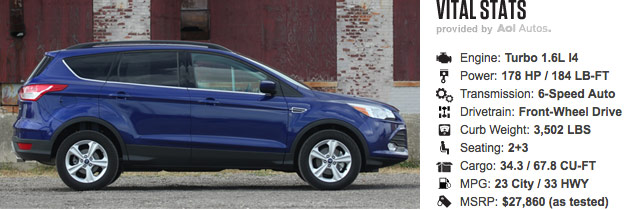
Mazda, on the other hand, went in a different direction. Rather than borrowing the bones from its Mazda3 compact, the Japanese automaker created an all-new platform that uses the full suite of lightweight, fuel efficiency-minded Skyactiv technologies – stuff that will quickly spread to every new model in the company's lineup, the next of which being the shapely new 2014 Mazda6. The end result is a crossover that sizes up very nicely to the Escape while being a full 230 pounds lighter in this spec.
Speaking of spec, let's talk about the vehicles that are being compared. We chose to go with the front-wheel-drive volume models for both, and various reasons contributed to this decision. Most importantly, price was a huge factor – you've no doubt heard about the fact that 2013 Escape models can retail as high as $37,000. But we also wanted the two vehicles to be as close as possible in terms of equipment levels and powertrains. Bigger-budget Ford offers three different four-cylinder engines in the Escape – one naturally aspirated, two turbocharged – while Mazda presently offers just the one Skyactiv four-cylinder in the CX-5. And while both crossovers can be had with all-wheel drive, we chose the front-wheel-drive versions simply because they're the ones most commonly purchased.
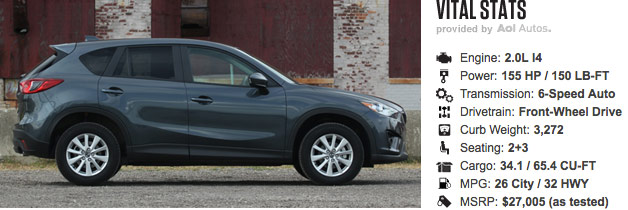
Dimensionally, the two crossovers are remarkably close in size. The Ford is 1.2 inches shorter in length than the Mazda (178.1 inches versus 179.3) and rides on a 0.4-inch shorter wheelbase (105.9 vs. 106.3). Both CUVs are identical in terms of width (72.4 inches) and the Ford is 0.6 inches taller (66.3 vs. 65.7). But while the widths might be the same for the two, it's important to note that the CX-5's front and rear tracks are a full inch wider than the Ford's – something that indeed helps with handling, but let's not get ahead of ourselves.
So, meet our 2013 Escape: An SE model with an as-tested price of $27,860, including $825 for destination. Under the hood is Ford's 1.6-liter EcoBoost inline-four, good for 178 horsepower at 5,700 rpm and 184 pound-feet of torque at 2,500 rpm, all of which is sent to the front wheels via a six-speed automatic transmission.
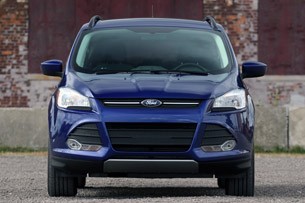
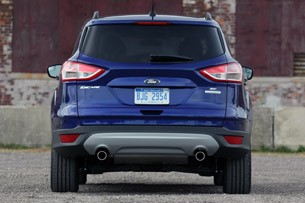
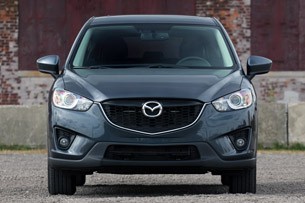
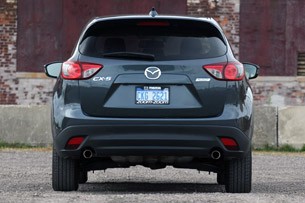
In terms of options, there aren't many here to talk about. SE models come standard with niceties like tinted rear windows, foglights and the five-spoke, 17-inch alloy wheels seen here. The only add-ons found on our vehicle were the $1,570 MyFord Touch navigation/infotainment system and the rolls-off-the-tongue Equipment Group 201A ($450; cargo cover, roof rails and perimeter alarm).
For the Mazda, we chose a 2013 CX-5 Touring, also riding on (decidedly more ordinary) 17-inch alloy wheels and powered by a 2.0-liter naturally aspirated Skyactiv inline-four that pumps out 155 horsepower at 6,000 rpm and 150 pound-feet of torque at 4,000 rpm, also mated to a six-speed auto 'box. The as-tested price: $27,005, including $795 for destination.
Again, we absolutely prefer the Ford's design in nearly every way, as specific elements of the CX-5's styling stick out as a bit odd to us. "The grille on the CX-5 looks outsized to me, and the front end too bluff, particularly from the dead-on front," writes Executive Editor Chris Paukert. "I'm not sure which will wear better over the long haul, but for the moment, the Ford looks fresher to my eyes." What's more, Touring models like our test car are only fitted with the smaller 17-inch alloys that leave huge gaps in the wheel wells, making the CX-5 look a bit awkward from most angles. If you want larger rollers, you have to option up for the Grand Touring, where you'll find attractive 19-inchers at all four corners.
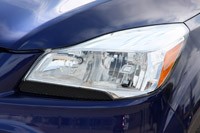
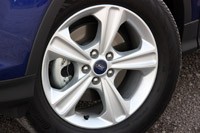
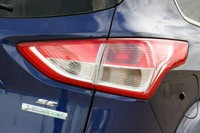
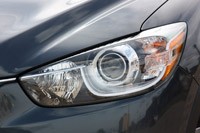
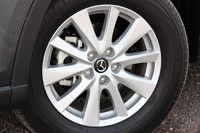
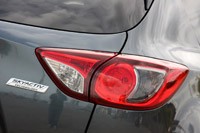
But even with this longer equipment list, a few of our editors took issue with the Mazda's option packaging. Paukert writes, "I find the CX-5's Byzantine trim and option scheme to be irritating. For example, short of the base Sport model, as a CX-5 buyer you're stuck with a mandatory Blind Spot Monitoring system, which can be annoying. I'm not convinced it's a feature everybody wants." Furthermore, "If you want satellite radio, you have pony up a pricey $525 for the stand-alone Sirius option on Touring models, splurge for the full-house Grand Touring or get a dealer-installed aftermarket system. What's up with that? That's standard equipment on a base $15k Hyundai Accent."
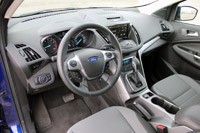
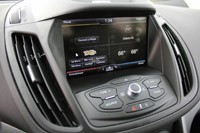
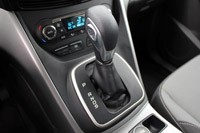
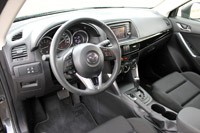
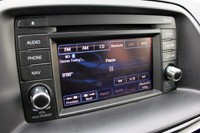
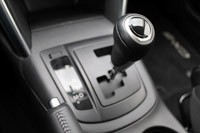
A lot of our discussions about the two crossovers' interiors are direct reflections of how we feel about their exterior designs. Basically, the Ford again impressed us with its more stylish cabin – "the interior feels like more design muscle was flexed in its creation," states Miersma.
But that isn't to say the CX-5 is anything even remotely bad. Miersma again: "Overall design makes the Mazda seem like a much older vehicle, too; the cabin doesn't feel 'ugly' so much as 'plain.'" We did find the CX-5's tech simple and easy to use, though far less pretty than the often-finicky MyFord Touch unit in the Escape. The Ford's larger display screen (that doesn't include a backup camera in this spec, unlike the Mazda) is a visual treat to behold, but even with the upgraded software, many of us had issues with the technology on board.
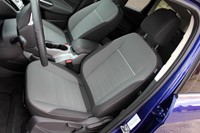
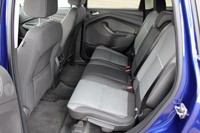
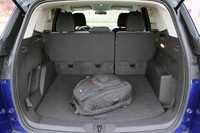
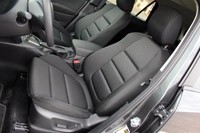
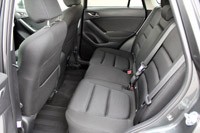
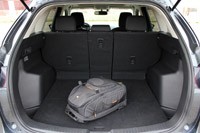
When we hit the road for some back-to-back driving, we quickly saw just how different these two seemingly similar crossovers really are. There's no doubt in our minds that the Escape offers the better engine. Not only is it more powerful – offering a full 23 hp and 34 lb-ft more oomph than the Mazda – it delivers its grunt in a much more balanced manner. The CX-5 suffers from a lack of low-end power that's easy to feel under acceleration, both from a stop and at speed, and you'll have to really rev it for maximum thrust. Various instrumented testing from other publications quotes 8.9-second 0-60 times for both CUVs, but the Mazda simply feels slower off the line.
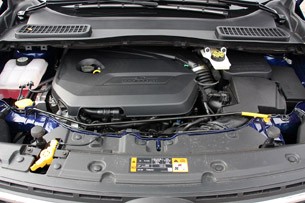
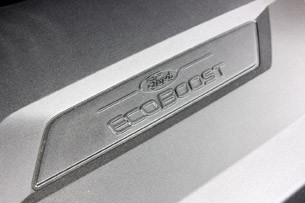
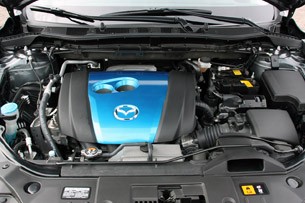
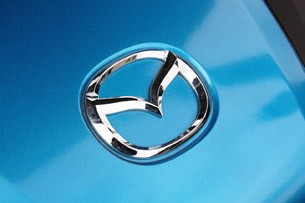
Still, we prefer the smoother shifts and calmer demeanor of the CX-5's six-speed Skyactiv automatic transmission. The Escape's six-speed automatic has a tendency to hunt for gears and downshift when you really only need a bit of torque thrust to increase speed, and even then, the changes aren't always smooth. In the CX-5, there are plenty of times where you don't even notice the transmission doing its work, which is greatly appreciated.
In every other aspect of driving, we continued to prefer the Mazda. It may be underpowered compared to the Ford, but remember, it's 230 pounds slimmer, and that sense of lightness really carries through to its driving dynamics. "The whole package just feels spryer on its feet," says Paukert. The CX-5's brakes felt better at both city and highway speeds, and there's less body roll in the corners. Suspension setups on both are well-tuned for typical crossover driving, but the Mazda just feels more willing to be pushed. Even so, we never found the Escape to have anything short of a smooth, comfortable ride, while still giving plenty of feedback to the driver that's in no way jarring.
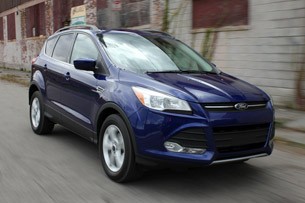
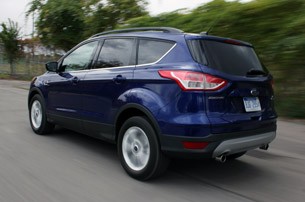
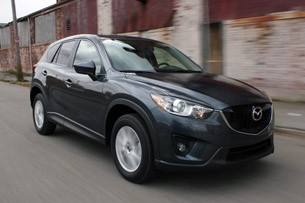
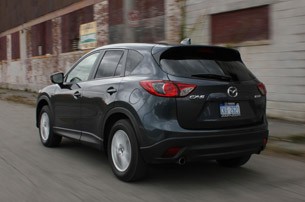
A big credit to the Ford, though, is the fact that it's quieter in terms of wind noise – by a significant amount, actually. We also noted that the Mazda was more prone to being blown around in heavy crosswinds. Interesting note: despite its wider track, the Mazda rides on P225/65-series tires whereas the Ford uses more robust 235/55-series rubbers, although the disparity doesn't seem to hurt the Mazda's handling any.
"I'd bet dollars to donuts that the Mazda's naturally aspirated Skyactiv four will return closer to EPA fuel economy numbers than the Ford's EcoBoost for just about every kind of driver – turbo DI engines just seem to have a harder time returning their advertised numbers," Paukert suggests. And from our week of driving each vehicle, he's right, too. While we didn't conduct any strict fuel economy testing, the Mazda had no issue returning highway fuel economy numbers around 31 mpg, while we never saw anything higher than 29 in the Escape. Take that all with a grain of salt, though – as they say, your mileage may vary.
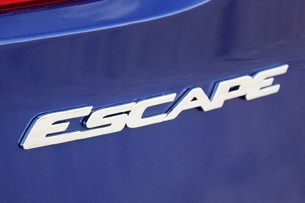
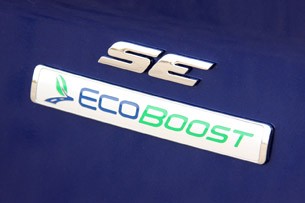
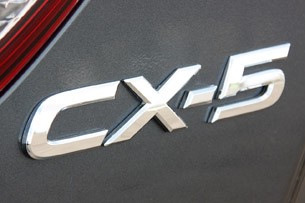
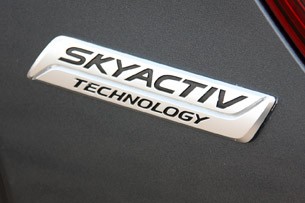
If we were only to judge these two crossovers based on their driving dynamics, the Mazda would be the outright winner, no question. But when you start to consider what makes each of these vehicles a good choice for shoppers in the segment, the Escape becomes more and more attractive with each item we list.
That in mind, picking a winner isn't as clean-cut as other comparisons. The Ford is more stylish both inside and out, but some of the Mazda's materials are just plain better and it offers more room for passengers. The Escape has a more powerful, more willing engine, but the Mazda counters by being lighter and using its power in a way that's absolutely more engaging out on the road.
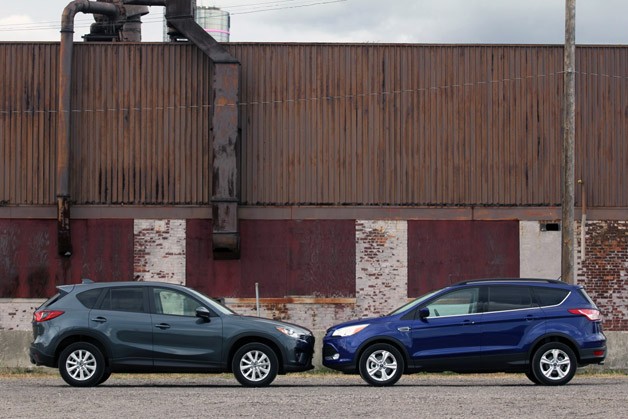
What we have here are two crossovers that offer a lot of kit and caboodle for buyers – one tailored more toward folks seeking an automobile as a stylish appliance, and the other with a sharper focus on being a rewarding vehicle to pilot. Mazda no longer needs Ford to have a worthy contender in this highly competitive segment, but there's no doubt in our minds that if the Escape took a few cues from its estranged brother, the outcome of this test would have been very different.
We couldn't do this comparison test a year ago. No, not because the CX-5 is a new nameplate and all-new vehicle for the Mazda brand (okay, that's technically a valid reason), but because until now, Mazda's only small crossover offering was the Tribute – a rebadged version of the trusty last-gen Ford Escape. In fact, it's always been sort of tricky to put Ford and Mazda vehicles in the same comparison test, only because nearly every product in Mazda's stable could be traced back to some sort of Ford platform.Not a single part is shared between these two crossovers.
But with the two automakers having officially parted ways, Mazda was forced to create an all-new platform for a small crossover that would play in the same segment as the Escape. And under the lights of the 2011 Los Angeles Auto Show last November, both the 2013 CX-5 and 2013 Escape debuted, with representatives from Ford and Mazda alike reassuring us that not a single part is shared between the two crossovers, noting that the two companies were in no way involved in the development of each other's vehicle.
That in mind, we thought it best to pit the Escape and CX-5 against one another to see how the family lines have matured after the divorce.
Both crossovers are completely new for the 2013 model year, the Escape ditching nearly everything that could possibly tie it to the boxier-than-thou 2012 model in favor of something decidedly more European in design and execution. Underpinning the new Escape is Ford's global C-segment platform, found elsewhere in the United States under the bodies of the Focus and C-Max.

Mazda, on the other hand, went in a different direction. Rather than borrowing the bones from its Mazda3 compact, the Japanese automaker created an all-new platform that uses the full suite of lightweight, fuel efficiency-minded Skyactiv technologies – stuff that will quickly spread to every new model in the company's lineup, the next of which being the shapely new 2014 Mazda6. The end result is a crossover that sizes up very nicely to the Escape while being a full 230 pounds lighter in this spec.
Speaking of spec, let's talk about the vehicles that are being compared. We chose to go with the front-wheel-drive volume models for both, and various reasons contributed to this decision. Most importantly, price was a huge factor – you've no doubt heard about the fact that 2013 Escape models can retail as high as $37,000. But we also wanted the two vehicles to be as close as possible in terms of equipment levels and powertrains. Bigger-budget Ford offers three different four-cylinder engines in the Escape – one naturally aspirated, two turbocharged – while Mazda presently offers just the one Skyactiv four-cylinder in the CX-5. And while both crossovers can be had with all-wheel drive, we chose the front-wheel-drive versions simply because they're the ones most commonly purchased.

Dimensionally, the two crossovers are remarkably close in size. The Ford is 1.2 inches shorter in length than the Mazda (178.1 inches versus 179.3) and rides on a 0.4-inch shorter wheelbase (105.9 vs. 106.3). Both CUVs are identical in terms of width (72.4 inches) and the Ford is 0.6 inches taller (66.3 vs. 65.7). But while the widths might be the same for the two, it's important to note that the CX-5's front and rear tracks are a full inch wider than the Ford's – something that indeed helps with handling, but let's not get ahead of ourselves.
Numbers don't accurately portray how these vehicles look on the road. In the metal, we found the Escape to be a far more handsome devil from every angle. As Senior Editor Seyth Miersma succinctly put it, "The Escape wins the 'wow factor' comparison, hands down." The Ford's stylized exterior is certainly more evocative, and unlike the Mazda, no design elements look awkward or misplaced. Even on the smaller 17-inch wheels, the Escape has a nice stance on the road, whereas the base wheels on the CX-5 almost look two inches too small.In the metal, we found the Escape to be a far more handsome devil from every angle.
So, meet our 2013 Escape: An SE model with an as-tested price of $27,860, including $825 for destination. Under the hood is Ford's 1.6-liter EcoBoost inline-four, good for 178 horsepower at 5,700 rpm and 184 pound-feet of torque at 2,500 rpm, all of which is sent to the front wheels via a six-speed automatic transmission.




In terms of options, there aren't many here to talk about. SE models come standard with niceties like tinted rear windows, foglights and the five-spoke, 17-inch alloy wheels seen here. The only add-ons found on our vehicle were the $1,570 MyFord Touch navigation/infotainment system and the rolls-off-the-tongue Equipment Group 201A ($450; cargo cover, roof rails and perimeter alarm).
For the Mazda, we chose a 2013 CX-5 Touring, also riding on (decidedly more ordinary) 17-inch alloy wheels and powered by a 2.0-liter naturally aspirated Skyactiv inline-four that pumps out 155 horsepower at 6,000 rpm and 150 pound-feet of torque at 4,000 rpm, also mated to a six-speed auto 'box. The as-tested price: $27,005, including $795 for destination.
Again, we absolutely prefer the Ford's design in nearly every way, as specific elements of the CX-5's styling stick out as a bit odd to us. "The grille on the CX-5 looks outsized to me, and the front end too bluff, particularly from the dead-on front," writes Executive Editor Chris Paukert. "I'm not sure which will wear better over the long haul, but for the moment, the Ford looks fresher to my eyes." What's more, Touring models like our test car are only fitted with the smaller 17-inch alloys that leave huge gaps in the wheel wells, making the CX-5 look a bit awkward from most angles. If you want larger rollers, you have to option up for the Grand Touring, where you'll find attractive 19-inchers at all four corners.






Our Mazda arrived packed with options like a power moonroof; a technology package that includes things like auto-leveling HID headlamps, navigation and rain-sensing wipers; and an upgraded Bose audio system. (For what it's worth, the base stereo in our test Escape was one of the worst modern units this author has ever tested in terms of sound quality.)The base stereo in our test Escape was one of the worst modern units this author has ever tested in terms of sound quality.
But even with this longer equipment list, a few of our editors took issue with the Mazda's option packaging. Paukert writes, "I find the CX-5's Byzantine trim and option scheme to be irritating. For example, short of the base Sport model, as a CX-5 buyer you're stuck with a mandatory Blind Spot Monitoring system, which can be annoying. I'm not convinced it's a feature everybody wants." Furthermore, "If you want satellite radio, you have pony up a pricey $525 for the stand-alone Sirius option on Touring models, splurge for the full-house Grand Touring or get a dealer-installed aftermarket system. What's up with that? That's standard equipment on a base $15k Hyundai Accent."



2013 Ford Escape interior



2013 Mazda CX-5 interior
A lot of our discussions about the two crossovers' interiors are direct reflections of how we feel about their exterior designs. Basically, the Ford again impressed us with its more stylish cabin – "the interior feels like more design muscle was flexed in its creation," states Miersma.
But that isn't to say the CX-5 is anything even remotely bad. Miersma again: "Overall design makes the Mazda seem like a much older vehicle, too; the cabin doesn't feel 'ugly' so much as 'plain.'" We did find the CX-5's tech simple and easy to use, though far less pretty than the often-finicky MyFord Touch unit in the Escape. The Ford's larger display screen (that doesn't include a backup camera in this spec, unlike the Mazda) is a visual treat to behold, but even with the upgraded software, many of us had issues with the technology on board.



2013 Ford Escape seating and cargo



2013 Mazda CX-5 seating and cargo
That said, both CUVs offer comfortable, well-appointed interiors in their mid-grade trim levels. All of us agreed that the Mazda felt roomier, despite the Escape's rakish windshield that creates a more airy feeling to the front cabin. The numbers don't lie, though – the CX-5 boasts 103.8 cubic feet of overall passenger volume whereas the Escape makes due with 98.1. We found the rear seats in both to be spacious and comfortable places to spend time. Headroom is identical in both vehicles, though the Mazda has an additional 2.5 inches of rear legroom. Cargo space in the CX-5 falls short of the Ford, though, even with the rear seats folded flat. The Mazda offers 65.4 cubic feet versus a more capacious 68.1 in the Escape.Cargo space in the CX-5 falls short of the Ford, even with the rear seats folded flat.
When we hit the road for some back-to-back driving, we quickly saw just how different these two seemingly similar crossovers really are. There's no doubt in our minds that the Escape offers the better engine. Not only is it more powerful – offering a full 23 hp and 34 lb-ft more oomph than the Mazda – it delivers its grunt in a much more balanced manner. The CX-5 suffers from a lack of low-end power that's easy to feel under acceleration, both from a stop and at speed, and you'll have to really rev it for maximum thrust. Various instrumented testing from other publications quotes 8.9-second 0-60 times for both CUVs, but the Mazda simply feels slower off the line.


2013 Ford Escape 1.6-liter turbocharged EcoBoost inline four-cylinder


2013 Mazda CX-5 2.0-liter Skyactiv inline four-cylinder
Still, we prefer the smoother shifts and calmer demeanor of the CX-5's six-speed Skyactiv automatic transmission. The Escape's six-speed automatic has a tendency to hunt for gears and downshift when you really only need a bit of torque thrust to increase speed, and even then, the changes aren't always smooth. In the CX-5, there are plenty of times where you don't even notice the transmission doing its work, which is greatly appreciated.
But this isn't the only area where the Mazda earns high praise – it's downright better to drive, full stop. The steering has a direct, linear feel with a solid on-center feel, whereas the Escape has moments where its wheel feels jerky and overboosted. Both crossovers use electric power steering, but Mazda indeed has the better formula for making its helm feel more engaging. Regarding the Escape, Editor Miersma writes that "the steering is so light and so numb that, driven back-to-back with the Mazda, it feels almost difficult to use confidently by comparison." There's also quite a bit of torque steer in the front-wheel-drive Escape under hard acceleration. Not cool.Both crossovers use electric power steering, but Mazda indeed has the better formula for making its helm feel more engaging.
In every other aspect of driving, we continued to prefer the Mazda. It may be underpowered compared to the Ford, but remember, it's 230 pounds slimmer, and that sense of lightness really carries through to its driving dynamics. "The whole package just feels spryer on its feet," says Paukert. The CX-5's brakes felt better at both city and highway speeds, and there's less body roll in the corners. Suspension setups on both are well-tuned for typical crossover driving, but the Mazda just feels more willing to be pushed. Even so, we never found the Escape to have anything short of a smooth, comfortable ride, while still giving plenty of feedback to the driver that's in no way jarring.




A big credit to the Ford, though, is the fact that it's quieter in terms of wind noise – by a significant amount, actually. We also noted that the Mazda was more prone to being blown around in heavy crosswinds. Interesting note: despite its wider track, the Mazda rides on P225/65-series tires whereas the Ford uses more robust 235/55-series rubbers, although the disparity doesn't seem to hurt the Mazda's handling any.
Speaking on fuel efficiency for a moment, both of these vehicles offer very respectable numbers for the class, though we mustn't forget that the base CX-5 Sport with the truly excellent six-speed manual 'box takes the best-in-class award for fuel efficiency. That said, the Escape 1.6L with front-wheel drive will net you 23 miles per gallon in the city and 33 on the highway, while the CX-5 FWD Touring is rated at 26 and 32, respectively. And while you might think the two would average out to the same sort of combined rating, that isn't necessarily the case.The Mazda had no issue returning highway fuel economy numbers around 31 mpg, while we never saw anything higher than 29 in the Escape.
"I'd bet dollars to donuts that the Mazda's naturally aspirated Skyactiv four will return closer to EPA fuel economy numbers than the Ford's EcoBoost for just about every kind of driver – turbo DI engines just seem to have a harder time returning their advertised numbers," Paukert suggests. And from our week of driving each vehicle, he's right, too. While we didn't conduct any strict fuel economy testing, the Mazda had no issue returning highway fuel economy numbers around 31 mpg, while we never saw anything higher than 29 in the Escape. Take that all with a grain of salt, though – as they say, your mileage may vary.




If we were only to judge these two crossovers based on their driving dynamics, the Mazda would be the outright winner, no question. But when you start to consider what makes each of these vehicles a good choice for shoppers in the segment, the Escape becomes more and more attractive with each item we list.
That in mind, picking a winner isn't as clean-cut as other comparisons. The Ford is more stylish both inside and out, but some of the Mazda's materials are just plain better and it offers more room for passengers. The Escape has a more powerful, more willing engine, but the Mazda counters by being lighter and using its power in a way that's absolutely more engaging out on the road.

At the end of the day, the CX-5 continued to be the crossover that we wanted to drive and the one we wanted to park in our driveways. And when it came time to vote for our favorite, every editor cast a ballot for the Mazda. "As a driver's car, the CX-5 is the pick," says Paukert, "but with its compelling styling and richer option count (not to mention a bigger dealer network and more generous roadside assistance warranty provision), I can see why the everyday driver would prefer the Escape. What's more, I don't think they'd be wrong for doing so."What we have here are two crossovers that offer a lot of kit and caboodle for buyers.
What we have here are two crossovers that offer a lot of kit and caboodle for buyers – one tailored more toward folks seeking an automobile as a stylish appliance, and the other with a sharper focus on being a rewarding vehicle to pilot. Mazda no longer needs Ford to have a worthy contender in this highly competitive segment, but there's no doubt in our minds that if the Escape took a few cues from its estranged brother, the outcome of this test would have been very different.

Sign in to post
Please sign in to leave a comment.
Continue